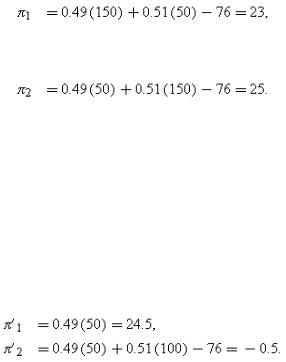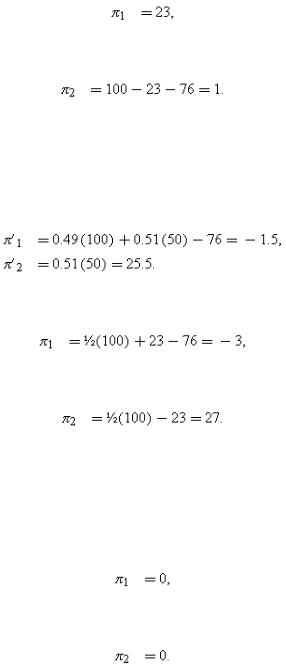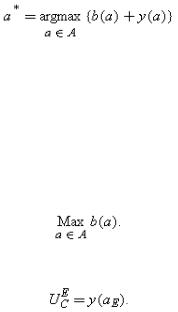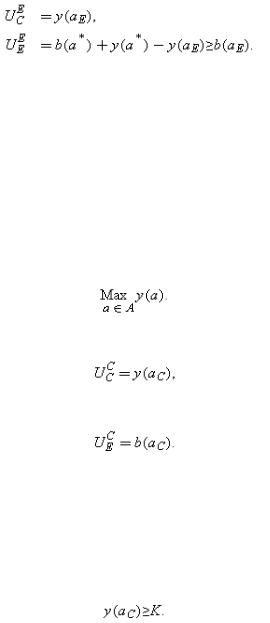
Учебный год 22-23 / Firms, Contracts, and Financial Structure
.pdf
90 |
I. UNDERSTANDING FIRMS |
option-to-own contracts can improve on the above arrangement. In particular, although the first-best is not achieved, one party invests for sure and the other party invests with some probability.
Consider the following ownership structure: M1 owns a* with probability σ=0.49 and M2 owns a* with probability 0.51. However, at date 1, before the randomization is made, M2 can buy out M1's ownership right for a price of 23. But, if (and only if) M2 tries to exercise her option, M1 has the right to buy M2's ownership right for 50. (In this case M2 does not pay the 23.)
Under this ownership structure the following is an equilibrium for any 0≤μ≤1/3: M2 invests for sure at date 0, and M1 invests with probability μ.
To understand this, consider the various possible ex post situations at date 1.
1.M1 and M2 Have Both Invested
If no buyouts occur, the parties' net payoffs are(4A.1)
(4A.2)
Note that, if M1 owns the asset, not only does he receive his own return of 100, but he can also hold up M2 for half of her return, so he gets 150 altogether. Similarly for M2.
If M2 buys out M1, M2 receives 100+1/2(100)−76−23=51 and M1 receives 23+1/2(100)−76=−3. However, M1 will pre-empt this by buying M2 out for 50, which makes M2's payoff equal to 50+1/2(100)−76=24. Since this is less than π2 in (4A.2), M2 will not initiate a buyout.
2.M1 Has not Invested, M2 Has Invested
If no buyouts occur, the parties' net payoffs are

4. THE INCOMPLETE CONTRACTING MODEL |
91 |
In this case M2 can do better by buying M1 out. This yields payoffs of(4A.3)
(4A.4)
M1 will not exercise his option, since his payoff would then be 1/2(100)−50=0.
3.M1 Has Invested, M2 Has not Invested
If no buyouts occur, the parties' net payoffs are
In this case M2 can do better by buying M1 out. This yields payoffs of(4A.5)
(4A.6)
M1 will not exercise his option, since his payoff would then be 100−50−76=−26.
4.Neither M1 Nor M2 Has Invested
If neither party invests, each party's net payoff is zero:(4A.7)
(4A.8)
Comparing (4A.1) and (4A.3), one sees that if M2 invests then M1 is indifferent between investing and not investing. Also, a comparison of (4A.2) and (4A.6), and (4A.4) and (4A.8) shows that if M1 invests then M2 would prefer not to invest, while if M1 does not invest M2 would prefer to invest. This suggests consideration of a mixed-strategy equilibrium, where M2 invests for sure and M1 invests with probability μ. In order to ensure that M2 invests, one requires

92 |
I. UNDERSTANDING FIRMS |
i.e. μ≤1/3. So there is a continuum of mixed-strategy equilibria. The surplus maximizing one is where μ=1/3. This equilibrium clearly dominates those that can be achieved through deterministic or stochastic ownership.
Part II Understanding Financial Structure
The first part of the book considered a situation where agents could afford to purchase the assets it was efficient for them to own. Part II relaxes this assumption and provides an analysis of firms' financial decisions. Chapter 5 studies the optimal financial contract written by an entrepreneur who raises funds for an investment project from a rich investor (or a set of investors). The issue is how control should be allocated between the entrepreneur and the investor(s). Chapter 6 discusses the role of capital structure in constraining the behaviour of the managers of a public company that has many small investors who find it difficult to exercise control. Chapter 7 is different in character from the rest of the book. It applies some of the ideas of Chapters 5 and 6 to study an important practical issue, the design of bankruptcy procedure. In contrast to the other chapters, there is no model and the analysis is fairly informal. Finally, Chapter 8 considers how votes should be allocated across shares in a public company, subject to a takeover threat. This chapter, unlike the others in Part II, is not concerned with debt, but shares with Chapters 6 and 7 the idea that automatic mechanisms—in this case take-overs—are an essential tool for controlling the management of a public company.
Since most of the large literature on capital structure does not (at least explicitly) take an incomplete contracting view, it is worth saying a few words about why incomplete contracting ideas provide a natural way to think about financial decisions.
In the absence of contracting costs, the parties to a transaction—entrepreneurs, managers and investors—would write an initial contract that anticipates all future events. Given that all decisions are specified, it is difficult to find a role for financial structure. For
94 |
II. UNDERSTANDING FINANCIAL STRUCTURE |
example, consider debt. The simplest interpretation of a debt contract is that a sequence of fixed payments is agreed to; if the payments are not made, creditors can foreclose on the debtor's assets and decide what to do with them. In a comprehensive contracting world, however, all the uses of the debtor's assets are specified and so there is nothing left for the creditors to decide. Or take equity. Equity is a claim with votes attached. But in a comprehensive contracting world there is nothing to vote on since there are no residual decisions. (Similarly, there is no role for the take-over mechanism, which relies on the idea that someone acquires enough votes to get control.) Finally, bankruptcy is a situation in which existing claims are inconsistent. Yet in a comprehensive contracting world such an event would be anticipated and the inconsistency removed in the contract. Thus, there would be no need for a formal bankruptcy procedure. These themes are elaborated on in the chapters below.
5 Theories of Financial Contracting and Debt
PREVIOUS chapters have shown that an agent should own an asset if he has important asset-specific investment decisions to make or if he has human capital essential for the asset's use. This chapter considers what happens if the agent is wealth-constrained and cannot buy the asset outright. Under these conditions, the agent will have to raise funds from an outside investor (or from a set of investors) to purchase the asset. This creates a new agency problem. The agent may behave opportunistically, thus depriving the investor of an adequate return on her investment.
The chapter studies how the investor can protect herself against such opportunistic behaviour. (I now depart from the buyer-seller relationship and focus on a single agent and a single investor.) One possibility is for the investor to take a controlling interest in the asset. However, the investor may then abuse her power; for example, she may sell the asset without taking into account the agent's benefit from operating it. It will be shown that in some cases it is better for the investor to enter into a financial contract with the agent of the following form. The agent borrows money from the investor and promises to make certain repayments. If he makes them, he retains control of the asset. If he does not make them, control shifts to the investor. In other words, the theory of incomplete contracts and property rights—when extended to the case of limited wealth—can explain the use of debt financing.
The chapter begins with a description of the leading incomplete contracting theory of debt, which is due to Aghion and Bolton (1992). I argue that the Aghion–Bolton model explains transfers in control but does not explain the use of a standard debt contract. Section 2 discusses a model, based on Hart and Moore (1989), which comes closer to justifying a standard debt contract. (For a related analysis, see Bolton and Scharfstein (1990).) The model in Section 2 extends for two periods and supposes perfect certainty. It turns out to be easy to generalize the analysis to many periods,
96 |
II. UNDERSTANDING FINANCIAL STRUCTURE |
and this is done in Section 3. (The discussion in Section 3 is based on Hart and Moore (1994a).) The dynamic version throws light on the maturity structure of debt repayment paths, and on the role of collateral in determining whether a project is financed. Section 4 introduces uncertainty into the two-period Hart-Moore model, while Section 5 considers the role of multiple investors in hardening the debtor's budget constraint.
The Appendix describes an alternative approach to debt contracting: the costly state verification (CSV) model, introduced by Townsend (1978) and developed by Gale and Hellwig (1985). The CSV model, which is a comprehensive contracting theory, has been an extremely effective workhorse for a wide variety of purposes, but I shall argue that it cannot explain some of the distinguishing features of debt.103 In this respect the incomplete contracting approach described in the main body of the chapter, even though it is at a much earlier stage of development, may be more fruitful in the long run.
This chapter is concerned with the case of a smallish, entrepreneurial firm, e.g. a closely held company, where there is no separation between ownership and control. Chapter 6 discusses how to extend the analysis to the case of a large public company. In this chapter, and in the remainder of Part II, the role of relationship-specific investments and holdup problems is de-emphasized, relative to Part I. Instead, the driving force of the analysis is the idea that an agent may receive private benefits from operating or managing an asset, and that he does not have the wealth to pay for these private benefits up front (i.e. to purchase the asset).
1.The Aghion–Bolton Model
To introduce the Aghion–Bolton model, it is useful to return to the notation of Chapter 2. Suppose that there is only one asset, a1,
103Also, the optimal contract in the CSV model can be interpreted as a debt contract only under fairly restrictive conditions. This is a problem with other leading comprehensive contracting models of debt too (e.g. Innes 1990). If the set of feasible contracts is very rich (as it is in a comprehensive contracting world), strong assumptions are required for the optimal contract to have the form of a simple debt contract.

5. FINANCIAL CONTRACTING AND DEBT |
97 |
and only one manager, M1, who works with this asset. However, an expenditure of K is required to construct the asset and the manager has no wealth of his own. The manager/entrepreneur approaches a (rich) investor for the funds. (I refer to the manager as an entrepreneur, E, the investor as a capitalist, C, and the asset as a project.) As in Chapters 2–4, suppose that a future action, denoted by a A, has to be taken with regard to the project, and this action is sufficiently complicated that it cannot be specified in an initial contract. Hence this action will be chosen by the project owner (who may be the entrepreneur or the investor). However, in contrast to Chapter 2, there are no relationshipspecific investments. Instead, the project yields two kinds of benefits: a monetary benefit y(a), which is verifiable and can be contracted on, and a private benefit b(a) for the entrepreneur, which is non-verifiable and non-transferable. Both y and b are measured in money terms, even though b is not actually in the form of money (so b represents utility measured in dollars or pounds). Ownership matters because there are conflicts of interest about the choice of action a. Moreover, because the entrepreneur is wealth-constrained, renegotiation does not necessarily resolve these conflicts; that is, the entrepreneur may not be able to bribe the investor to choose a surplus-maximizing choice of a. (This is in contrast to Chapter 2, where negotiation always led to an ex post surplus-maximizing outcome.)
Examples of private benefits might be an entrepreneur's desire to keep a family-owned business going, even though it is not very profitable, the entrepreneur's consumption of perks, or the entrepreneur's disutility from dismissing longstanding employees.
In what follows, I simplify matters by supposing that the contract allocates all the monetary returns y(a) to C (that is, C is allocated all the ‘dividends’ from the project). It follows that the payoffs to the parties are
This is a natural case to look at since, as will become apparent, the parties wish to devise a contract that gives E maximum freedom to pursue his private goals, but which compensates C for her investment. Other arrangements are however possible; these are

98 |
II. UNDERSTANDING FINANCIAL STRUCTURE |
discussed later in the chapter. It is also supposed that there is symmetric information and the interest rate is zero.104
Start by considering the ‘first-best’. By first-best I mean a situation where E is not wealth-constrained and hence arbitrary side-payments can be made ex post.105 Under these conditions, whoever has control, the parties will bargain to the point where total surplus b+y is maximized and will allocate this surplus using side-payments. Let
be the first-best optimal action (assumed unique).
Turn next to the second-best, where E has no wealth. Consider first what happens if E owns and controls the project.
EControl
Econtrol corresponds to the case where E has voting equity and C has non-voting equity (and all the dividends).
Without renegotiation, E would solve the following problem:
Denote the solution by aE (assumed unique). Then C's payoff in the absence of renegotiation is
However, renegotiation will take place. To simplify matters, suppose that E has all the bargaining power, both ex post and ex ante when the contract is written.106 Then E will offer to choose the first-best action a* in return for a payment of y(a*)–y(aE) from C. Note that this payment is non-negative since, by the definitions of a* and aE, b(a*)+y(a*)≥b(aE)+y(aE) and b(aE)≥b(a*), from which it follows that y(a*)≥y(aE). The two parties' payoffs will be
104 |
I make the further technical assumptions that A is a compact, convex subset of Euclidean space and that y |
and b are continuous and concave in a. |
105 |
This is not the only possible interpretation of first-best. First-best could also refer to a situation where a is ex ante |
contractible. In the present context, it is more convenient |
|
to use the no-wealth-constraint case as a benchmark. Note, of course, that if E is not wealth-constrained he can finance the project himself. |
|
106 |
This is a reasonable assumption if there are only a few entrepreneurs with good ideas but many investors with capital for projects. |
|

5. FINANCIAL CONTRACTING AND DEBT |
99 |
Clearly, if y(aE)≥K, E control achieves the first-best since C breaks even and an efficient action is chosen. (Given that E has all the bargaining power, if y(aE)>K, C will make an initial lump-sum payment of y(aE)−K to E.) The interesting case is where y(aE)<K, that is, where the first-best is not feasible. Under these conditions, it may be necessary to give C control.
CControl
Ccontrol corresponds to the case where C has all the voting equity. Without renegotiation, C would solve the
following problem:
Denote the solution by aC (assumed unique). Then C's payoff in the absence of renegotiation is
and E's is
In fact, no renegotiation will occur. The reason is that any other action by definition yields a lower value of y than does aC. Hence E cannot compensate C for taking the action, since he has no wealth.
Clearly, the sum of the parties' payoffs will be smaller under C control than under E control since a is chosen to maximize y rather than (b+y). However, C's payoff will be larger. From now on assume(5.1)
If (5.1) were not satisfied, the project would not be undertaken at all.
The interesting case is where (5.1) holds strictly. Under these conditions, it may be optimal to give E and C each control with positive probability. Suppose E and C are risk-neutral. Then E will own the project with probability σ and C will own it with probability (1−σ), where σ is chosen so that C breaks even on average:
